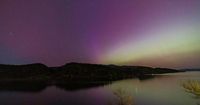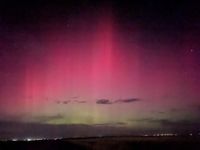As a rare and powerful G4 geomagnetic storm swept across North America from May 31 into June 2, 2025, residents from Colorado to the Washington, D.C. area were treated to a spectacular celestial show—the Northern Lights, or aurora borealis, visible far farther south than usual. This storm, triggered by a halo coronal mass ejection (CME) erupting from the sun on May 30, collided with Earth's magnetic field, setting off a series of geomagnetic disturbances that painted the night skies with vibrant hues of green, pink, purple, and even red.
The National Oceanic and Atmospheric Administration (NOAA) reported that the CME struck early on June 1, accelerating solar wind speeds to over 900 kilometers per second and sparking a G4-class geomagnetic storm—the second strongest on the NOAA scale. Such storms are rare and powerful enough to push the auroras to much lower latitudes than typical, creating a unique viewing opportunity for millions of Americans and Canadians alike.
In Colorado, the storm’s effects were particularly vivid. The aurora was visible with the naked eye as far south as the state, an unusual sight that drew amateur photographers and skywatchers outside in droves. Denver7’s Facebook group, Discover Colorado | Through Your Photos, showcased stunning images of glowing bands of green interspersed with shades of pink and purple streaking across the night sky. According to NOAA, these colors result from collisions between charged solar particles and gases in Earth’s atmosphere—a natural light show fueled by solar activity.
The storm’s intensity peaked earlier than initially forecast, on the night of May 31, due to atmospheric conditions and the earlier-than-expected arrival of the coronal mass ejection. Although the strongest activity was concentrated then, weaker auroras remained visible into the early hours of June 2, with NOAA predicting the geomagnetic disturbances would subside by June 3.
For those eager to catch a glimpse of the aurora, experts emphasized the importance of ideal viewing conditions. CBS News Colorado and other outlets advised skywatchers to seek out dark, clear skies free from light pollution, especially away from urban centers like Denver. The northern horizon was the best direction to watch, as the aurora often appears low in the sky at these latitudes. Nighttime visibility, cloud-free conditions, and minimal artificial light were key to spotting the delicate bands of color.
Meanwhile, residents in the Washington, D.C. area and as far south as Alabama and northern California were also hopeful. FOX 5 DC reported a more than 50% chance of seeing the Northern Lights on the night of June 1 into early June 2, with NOAA’s Space Weather Prediction Center forecasting clear skies over the capital region. The aurora was expected to be less intense than the historic geomagnetic storm of May 10, 2024, which had produced a dazzling multi-night display worldwide, but the 11 solar flares recorded during this event—including one major outburst—kept anticipation high.
Despite the breathtaking visuals, the storm’s power also raised concerns. NOAA warned that strong geomagnetic storms like this can induce currents in power grids, potentially causing voltage fluctuations and even tripping protective systems offline. Pipeline operators might see intensified induced currents, and navigation and communication systems could face disruptions. Erratic GPS signals and blackouts of high-frequency radio communications were among the possible impacts, underscoring the dual nature of such solar events as both beautiful and disruptive.
Space weather officials noted that the storm’s orientation had been trending northward, which somewhat limited the southern reach and brightness of the aurora. However, they cautioned that if the storm shifted southward, activity could escalate rapidly, potentially expanding the aurora’s visibility and increasing geomagnetic impacts. Maps from the Space Weather Prediction Center showed the aurora’s projected reach on June 1 included the northern tip of Colorado and extended into northern U.S. states near the Canadian border.
Indeed, several northern states—including Alaska, Montana, North Dakota, Minnesota, and others—had a higher chance of seeing the aurora borealis on June 1 and June 2. NOAA listed 24 states with potential visibility, spanning from Alaska to parts of New England and the northern Midwest. Although the likelihood of sightings diminished on the night of June 2, skywatchers were encouraged to remain alert, as geomagnetic activity could persist in varying degrees.
While the aurora is not visible during daylight hours, it can be spotted from as far as 621 miles away when bright enough, even if not directly overhead. This meant that observers in locations farther south than usual had a rare opportunity to witness this spectacular natural phenomenon. Cell phone cameras and other photographic equipment were noted as helpful tools to enhance and capture the colors, which can sometimes be faint to the naked eye.
As the geomagnetic storm gradually waned, experts reminded the public that such events are part of the sun’s natural cycle and that monitoring space weather remains crucial for protecting technology-dependent infrastructure. The recent display served as a vivid reminder of our planet’s connection to solar activity and the awe-inspiring beauty that can emerge from this cosmic interplay.





